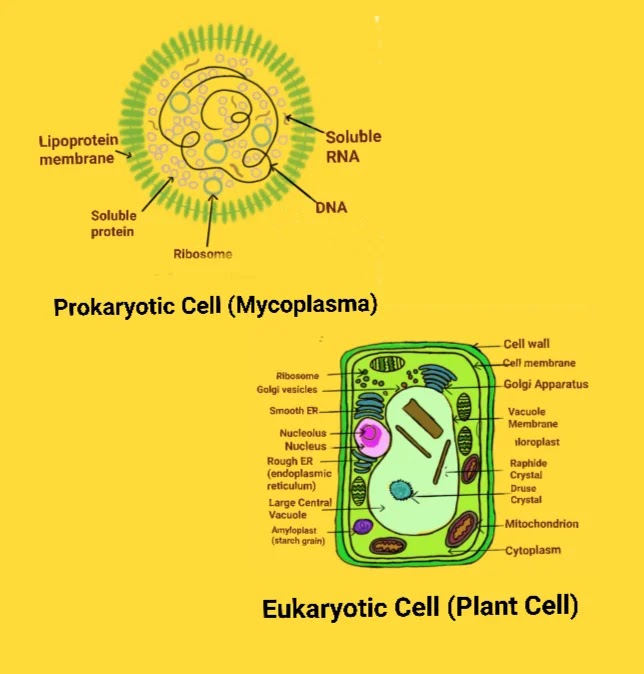Kingdom Monera is a part of class 7 biology chapters ICSC. This chapter has three parts. Please check the part 1 of this chapter before reading this topic (part 2).
In 1969, RH Whitaker suggested the five kingdom classification to overcome the demerits of the two kingdom classification. He divided the organisms on the basis of the following criteria -
1. Structure of the cell - He kept prokaryotic and eukaryotic organisms under different groups.
2. Mode of nutrition - Autotrophic and heterotrophic organisms were kept under different groups.
3. Body organization - Unicellular or multicellular organisms were kept under different groups.
Five Kingdom Classification
It includes the following five kingdoms
1. Kingdom Monera
2. Kingdom Protista
3. Kingdom Fungi
4. Kingdom Plantae
5. Kingdom Animalia
1. Kingdom Monera - It includes the oldest, prokaryotic and unicellular organisms.Membrane based organelles such as chloroplasts and mitochondria are absent.Some of them consists of a cell wall like plants that gives protection and shape to the cell. Some of them lack cell wall such as mycoplasma. Most of the organisms don't move but some of them can move with the help of flagella. Most of them have autotrophic mode of nutrition such as cyanobacteria, blue green algae etc while some of them have heterotrophic mode of nutrition such as bacteria,mycoplasma etc.
 |
| Prokaryotic and Eukaryotic cell |
Bacteria
Bacteria are the most primitive, simplest and unicellular organisms that don't have a true nucleus. Their size varies from 0.2 to 100 microns. They can be seen only with the help of a microscope. Bacteria can be found in the following four shapes -
(a) Rod shaped (Bacilli) - For example - Lactobacillus, Escherichia Coli (found in the human intestine)
(b) Spherical (Cocci) - For example - Streptococcus
(c) Spherical or curved shaped bacteria (Spirilla) - For example - Treponoma
(d) Comma shaped (Vibrio) - Vibrio cholerae (causes cholera)
What are the uses of bacteria?
1. Bacteria are used for a variety of purposes such as curdling of milk, production of vinegar and cheese, tanning of leather, processing of tobacco, coffee etc.
2. They help in synthesizing vitamin B in our body.
3. They help in the formation of certain antibiotics such as aureomycin,streptomycin (cures TB).
4. Some bacteria such as clostridium, azotobacter are found in the root nodules of the leguminous plants and help in fixing atmospheric nitrogen into nitrates.
5. They help in decomposing dead and decayed matter and help in cleaning the environment.
What are the harmful effects of bacteria?
1.They spoil food items such as fruits, vegetables, milk, meat etc and release toxins in these that cause food poisoning. They cause Botulism which is a food poisoning disease.
2. It may cause cholera, dysentery, tetanus, TB, leprosy etc.
3. It may cause anthrax, tuberculosis etc in animals.
4. It may also cause many diseases in plants such as bacterial blite in beans (caused by xanthomonas campestris) and leaf spot disease in cotton.
2. Kingdom Protista - It includes unicellular (or colonial) , eukaryotic organisms with complex membranous organelles. They may have autotrophic or heterotrophic mode of nutrition. Some of them have cell wall and chloroplast such as algae and are autotrophic. Some of them don't have cell wall and chloroplast and are heterotrophic. Some of them have cilia (hair like structures), flagella or pseudopodia (whip like structures) that help them in movement. For example - amoeba, paramecium, euglena etc.
Amoeba
It is a type of free living protozoa which is mostly found in freshwater such as lakes, ponds, ditches etc. It has false feet or pseudopodia that helps in its movement. Its movement is known as amoeboid movement and is very slow. It has holozoic mode of nutrition. Food particles are captured in its false feet. In amoeba respiration occurs through its cell membrane. CO2 is released during the process of respiration. It releases CO2 and ammonia as waste products with the help of contractile vacuole.Waste materials present in the cytoplasm moves to the vacuole and then goes to the plasma membrane. The contents are released into the surroundings after it bursts. Reproduction is asexual. They reproduce through binary fission or multiple fission.
(a) Binary fission - In this type of asexual reproduction, one parent is divided to form two daughter cells.
 |
| Binary Fission |
(b) Multiple fission - In this type of asexual reproduction, one parent is divided to form multiple daughter cells.
 |
| Multiple Fission |
Matter/ Matter Properties + Worksheets
ECG - How to read + Worksheets
Infection in Kidneys + Worksheets





0 Comments